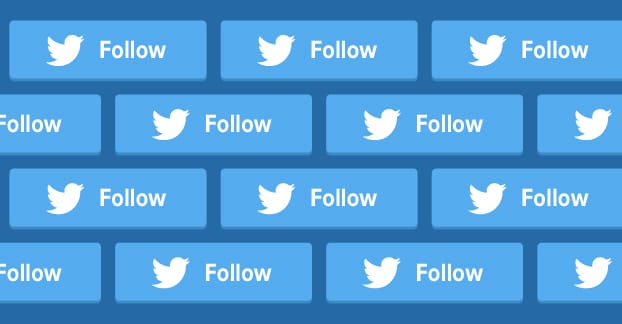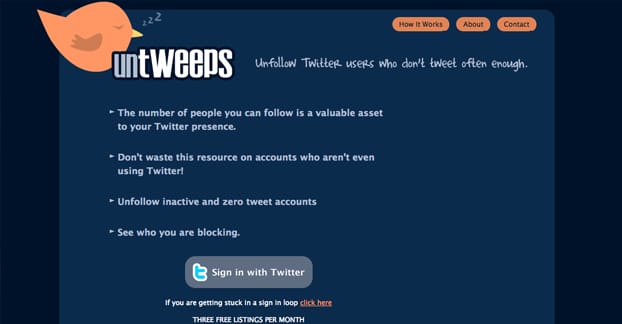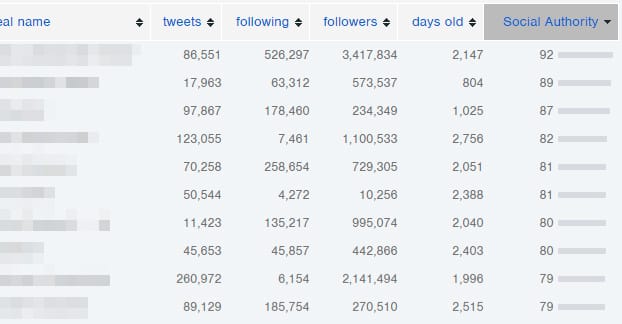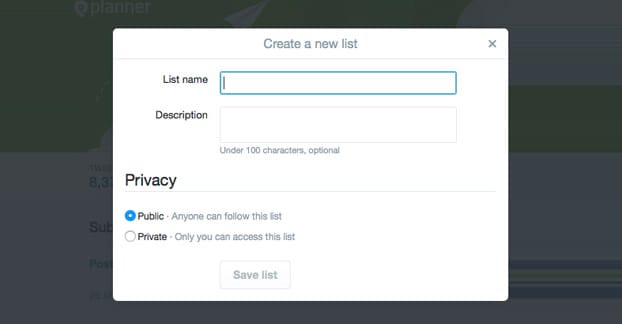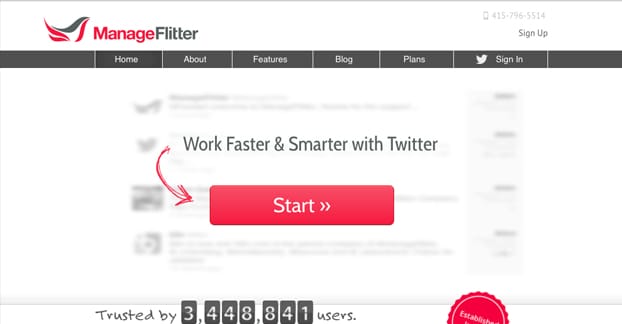In the process of growing a Twitter profile, chances are pretty good that you’ve followed a lot of accounts. This will be true regardless of whether or not you’re trying to use the follow/unfollow method, or just fishing for follow-backs, or abusing the old Followback Friday trends. There are a ton of reasons why you’ll follow people, and it very quickly goes from a minor hindrance to completely out of hand.
For example, I have a test account that follows about 100 active users. With only that number of follows, the feed is pretty fast-moving during peak hours, and there’s always new content to see. I can’t keep up with all of it, and I don’t try to. Imagine, then, what it would be like to follow 10x that many people, or 100x, or more. It’s not uncommon to see Twitter profile that follow hundreds of thousands of people.
Before we begin, I’d like to note that I’m not giving you instructions about cleaning up the people who follow you, though many of the tools I mention will allow you to do that if you desire. Instead, I’m talking about going through and auditing the people you follow.
Second, a word of warning. When you’re unfollowing people, be very careful to do it slowly, gradually, and above all, manually. Many of the tools I mention have API-based methods to unfollow users, but that kind of automation is explicitly something that can get your account blocked. Now, Twitter will likely forgive you if it’s just one moderate burst of activity, but if you’re going to take this in sessions, be very careful. Batch-based unfollowing of mass accounts is one of the signs of the follow/unfollow method, known to Twitter as follower churn, and it’s something they really don’t like to see.
Auditing Followers
The tool I prefer for auditing the people you follow, and your followers, is Twitonomy. I’ve written about it before – and linked to that post numerous times – so you should know how much I like it. It’s probably one of the best Twitter analytics suites available for free, though they do also have paid features if you’re interested in those as well.
In addition to Twitonomy, you can use other tools like UnTweeps to do the same thing. I’m going to assume you’re using Twitonomy, though, even if the steps are general enough to apply to any auditor.
The first thing you want to do is check to see the list of people you follow who are inactive. In Twitonomy, go to the “following” tab up at the top. It will pull data from your Twitter account, showing you the picture, name and username, bio, URL, and location of all of the people you follow. It will tell you when they joined and whether or not they follow you back. It will tell you how many times they’ve tweeted, how many people they follow, how many people follow them, how many lists they’re on, and most importantly, when the last time they tweeted was.
This last column, “last tweet” is something you should click. This will sort by last tweet date, starting with oldest first. My test account has a few people it follows that have not tweeted in over a year.
Now, inactive accounts aren’t going to be your biggest problem, so you can go light with the unfollow button here. Any account that follows you back is fine to leave. Any account owned by someone you like to support, even if they’re not active, is fine to leave. Accounts for friends and family you can leave or unfollow at your discretion.
The primary reason you might want to unfollow these people is because your follow:follower ratio is somewhat important. When you follow almost as many people as the number of people who follow you, you look like you abused follow/unfollow or followbacks to get where you are. People become skeptical about how much you actually get out of Twitter. After all, how many tweets do you actually see in a day? 1,000? When tens or hundreds of thousands of tweets pass through your feed every day, it’s impossible to keep up with them all. Something has to give, and it’s usually engagement.
Next, I like to sort by number of tweets. This will tend to correlate with tweet frequency, though not always. Look at the people who tweet extremely frequently, and see if those are people you want to follow.
Again, anyone who follows you back can certainly stay. You don’t want to ping their unfollow notification and get unfollowed in return. Other accounts, though, you might want to drop. For example, my test account follows an account that constantly – several times an hour, all day – tweets curated news. Nine times out of ten, I find that I don’t really care about what they’re posting. That would be a good target to unfollow. I could find a slower, more curated news account to follow instead.
Another example is the author William Gibson, who is arguably the creator of cyberpunk and author of Neuromancer. He tweets a lot, but a lot of what he tweets is retweeting. He obviously doesn’t follow my test account, and a lot of what he retweets, I see other followers retweeting as well. In large part, his feed is redundant to mine, so he’s not bringing much value to the table personally. Others he may be, though, so that’s a personal determination.
The goal here is to find accounts that are essentially spamming your feed but are not adding significant value. You should drop them so you have more attention to give to more valuable tweeters on your feed.
Next, sort by the number of followers. Look for the people with the fewest followers who you follow. This list is likely going to be full of personal friends and relatively disinterested Twitter users, so a lot of them will be accounts you want to keep following. Some, though, may just be people you followed to fish for a follow in return, or who you expected were going to be more active and popular than they are. Maybe you followed that electric eel as a joke but the joke has gotten stale. Talk about fishing for follows, eh? No? Sorry.
Next, it’s time to do a more manual overview. Just go through your feed, spend an hour or two scrolling back, and look for accounts that stand out as people who aren’t posting what you want to see. Even if they’re influencers, if they’re in the wrong industry, what value are they to you? You want to network with influencers who can bring something to your table, not influencers who just bring something to theirs. You also might find accounts that are posting spam or accounts that always seem to post something later than someone else, and those are good targets to unfollow.
Next, do the same thing, but to your following list. Just click the number of people you’re following on your actual Twitter page and scan through the accounts. You don’t have to go deep looking at every one, just pick the ones that seem the least interesting or valuable, and determine on the spot if they’re really worth continuing to follow.
Build a List
The next tool for managing your Twitter followers is to convert some of them to lists. Identify a particular group of accounts that you follow because you want to see what they post, but that are unlikely to follow you back or retweet your content. These tend to be aggregator account or accounts that are influencers who don’t care about following anyone. The people “too big to fail” go in this category.
What you should do is go to Twitter and create a new list on your profile page. Make this list private; it’s basically just going to act like a specialized feed you can look at when you want to see what these people are saying. Add these people to the list and, once they’re on it, unfollow them.
What this does is removes their clutter from your general feed, and builds a specialized feed where you can see what they’re posting without having it in your face at all times.
It’s up to you how specialized you want these lists to be. I like to have a few of them. Different industries, different types of accounts, maybe put all the various parody and bot accounts into a list so you’re not using following slots on them, that sort of thing. How you organize it is up to you. There are just two rules to follow. First, the list should be private, since it’s just for your own personal use. Second, anyone you add to the list should be unfollowed.
You can make a public list of influencers as a way to get in their good graces, as well. A list like “awesome people” that you fill with your top influencers and most high value targets for engagement can get you noticed. That’s another story and another technique altogether, though.
Now, how do you keep up with your lists? One option is to use Tweetdeck. Tweetdeck is Twitter’s default management tool, and it comes with a columnar layout with feeds for your basic feed, your notifications, and your messages. If you have lists, you can also add columns for your lists. This allows you to keep all of your feeds in view, without forgetting about them or cluttering up your main feed if you just want to set the lists aside for a while.
What I like to do is use Tweetdeck at my “home base” where I post, engage, and interact with Twitter. This is where I want to access lists, because I’m more likely to be curating content. Then, if I’m out and about, on a different machine, or generally away from home base, I use the regular Twitter client. The lighter flow of the base feed still keeps me in touch with the most important happenings, but doesn’t flood me with posts like the column feeds of Tweetdeck.
The Nuclear Option
There’s one option some of you are itching to use, but I’m hesitant to talk about it. It’s the simple unfollow everyone” or “unfollow everyone who doesn’t follow me” option. It’s a sure way to get a great ratio, but it’s also likely going to miff a few users. More importantly, though, that sort of mass unfollow is going to put you on Twitter’s radar, and if they decide you’re abusing the system, it can get you suspended.
If you’re interested in using this kind of option, you should use a tool like ManageFlitter to do it. They have a lot of good automation features and they also analyze the people you follow to see what sort of value they bring to the table. In addition, they can audit your followers to see if there are spam accounts following you, and allow you to block them to maintain the purity of your audience.
There are a handful of other tools you can use for the same purposes. Harsh Agrawal covered them pretty well over at ShoutMeLoud, so check out that post.
Again, I always recommend being cautious with your mass unfollowing. The last thing you need is to get your account suspended, in a way that is going to be difficult to recover from. It tends to put you on Twitter’s hit list, and makes them less likely to give you the benefit of the doubt in future issues. It can also hurt your chances at verification, though there’s no actual statement from Twitter about that.
Regardless, pruning down your following list is generally a good idea. I like to go through and prune it down about once every six months. Any longer and it becomes a monumental task, but any more often and it’s straying into the realm of daily maintenance. Which, by the way, you should be doing. Any time you notice an account you tend to glaze over, see if it would be better off in a list or simply removed.
